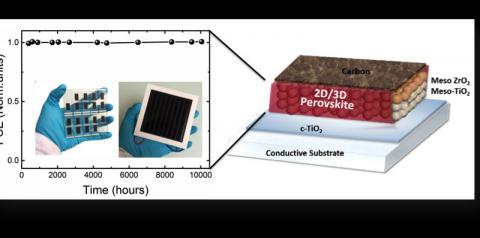EPFL Researchers, in collaboration with Michael Grätzel and Solaronix, have designed a low-cost and ultra-stable perovskite solar cell that has been operating at 11.2% efficiency for over a year, without loss in performance. This may represent a step towards solving the stability problem that currently poses a major obstacle towards commercialization of perovskite-based solar cell technology.

The team engineered what is known as a 2D/3D hybrid perovskite solar cell. This combines the enhanced stability of 2D perovskites with 3D forms, which efficiently absorb light across the entire visible spectrum and transport electrical charges. In this way, the scientists were able to fabricate efficient and ultra-stable solar cells, which is a crucial step for upscaling to a commercial level. The 2D/3D perovskite yields efficiencies of 12.9% (carbon-based architecture), and 14.6% (standard mesoporous solar cells).